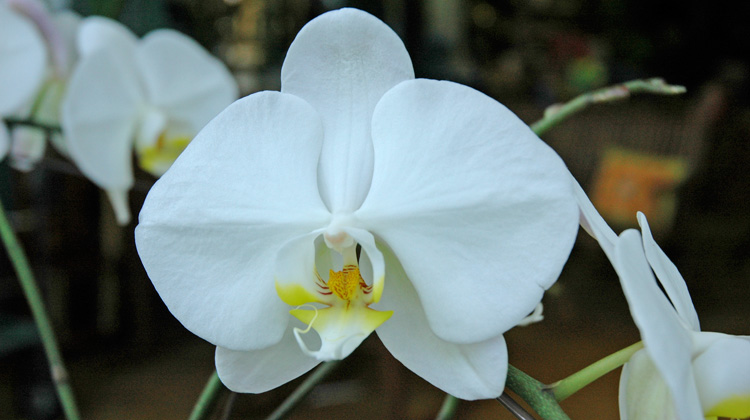
Keep Orchids Beautiful and Blooming
Lift your spirits, enliven your indoor décor or give the gift of beautiful blooming orchids. You’ll enjoy these exotic blossoms for months with just minimal care – once you know what to do.
Start with a healthy flowering plant. The phalaenopsis or moth orchid is the most widely available and easiest to grow. It’s similar to caring for an African violet. When you provide the proper growing conditions, maintenance is a breeze.
The challenge comes with less-than-ideal indoor growing conditions of low light and dry air. Fortunately, there are a few things you can do to create a better environment for your orchid.
Keep in mind that most orchids are epiphytes. In nature they grow on other plants and obtain water and nutrients from the air, water and plant debris that accumulates in their environment. This is why they are grown in an orchid mix made of organic material such as peat, fir bark and perlite. This or a similar combination retains water while providing needed drainage.
Give your orchid a good soaking once a week. Pour off any excess water that collects in the saucer. Don’t allow orchids to sit in water and don’t water them too often. This can lead to root rot and death of your plant.
Further improve the environment by increasing the humidity around the plant. Group them with other orchids and indoor plants. As one plant loses moisture, or “transpires”, the others will benefit from the increase in humidity. Plus, you’ll create a beautiful display while improving the growing conditions.
Alternatively, you can create humidity trays. Place pebbles in the saucer and the pot on top of the pebbles. Allow excess water to collect in the pebbles below the pot. As this evaporates it increases the humidity around your plant. This also eliminates the need to pour off the excess water that collects in the saucer.
For larger plant collections use rubber humidity plant tray grids. These save space by allowing you to place several plants on one tray. These are perfect for growing on tables or light stands.
Place your plant in a bright location. Orchids do best with 12 to 14 hours of sunlight. Unobstructed south- or east-facing windows are usually the best. Or give plants a boost with artificial lights. Newer full spectrum LED lights provide needed light while using less energy.
And there’s no reason to hide your orchid and light setup in the basement. Check out the attractive, new indoor grow light systems like the Coltura LED Grow Frame. It can be mounted on the wall or set on a table. Either way, your orchids will be in full view for all to enjoy.
Fertilize actively growing plants with an orchid fertilizer. Michigan State University developed a fertilizer that efficiently provides the nutrients orchids need. They have “Orchid Tap Water” and “Orchid Pure Water Fertilizer” formulations. Just follow label directions for best results.
Once the plants are done flowering, you can keep them growing indoors. If you like a challenge, try reblooming. On phalaenopsis orchids, just cut back the flowering stem between the second or third node from the bottom. Or give the plant a rest and cut the flower stem back to the leaves. Continue to provide proper care and wait to see if you were successful.
You can also simply treat an orchid plant like a long-lasting bouquet. That way there’s no guilt if you decide to toss it. And if the guilt is too much, just look for an avid gardener. There’s always someone who would be happy to adopt and try to rebloom your non-flowering plant.
Related
Upcoming Live Events
& Webinars
April 27, 2024
Ridges & Rivers Book Festival
Viroqua, WI
Register now
April 28, 2024
Flowering Trees and Shrubs
Ebert's Greenhouse Village, Ixonia, WI
May 1, 2024
FREE WEBINAR
Ornamental Fruits and Vegetables
Register now
May 4, 2024
Garden U 2024
New Richmond, WI
Register now
May 9, 2024
FREE WEBINAR
How to Plant Your Rain Garden
Register now
May 11, 2024
Ask The Plant Doctor Q & A
Ebert's Greenhouse Village, Ixonia, WI
May 12, 2024
Ask The Plant Doctor Q & A
Ebert's Greenhouse Village, Ixonia, WI
May 18, 2024
Ask The Plant Doctor Q & A
Ebert's Greenhouse Village, Ixonia, WI
June 1, 2024
Selecting, Planting, Pruning and Caring for Hydrangeas
Ebert's Greenhouse Village, Ixonia, WI
June 5, 2024
FREE WEBINAR
Under-Appreciated Pollinators
Register now
WATCH ON-DEMAND WEBINARS
Learn More













